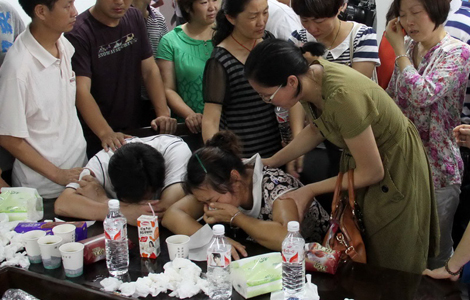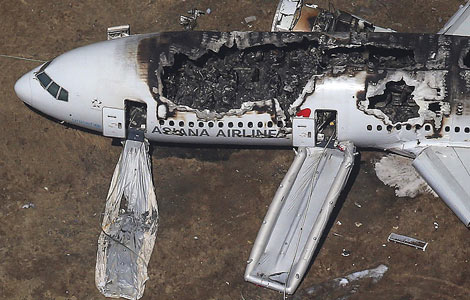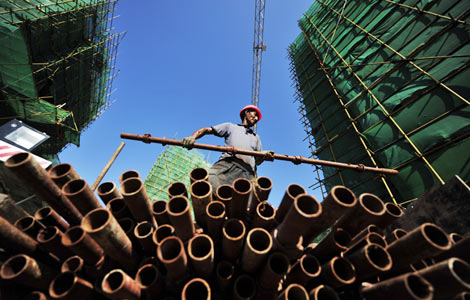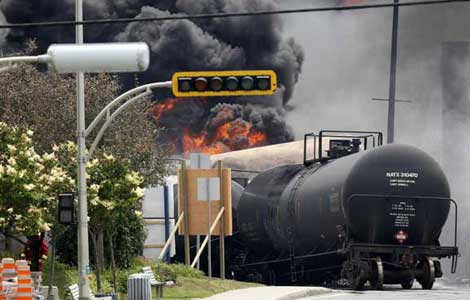
SAN FRANCISCO/SEOUL - The pilot of the crashed Asiana plane at San Francisco airport was still "in training" for the Boeing 777 when he attempted to land the aircraft under supervision on Saturday, the South Korean airline said.
Lee Kang-kuk, whose anglicised name was released for the first time on Monday and differed slightly from earlier usage, was the second most junior pilot of four on board the Asiana Airlines aircraft and had 43 hours' experience flying the long-range jet, the airline said on Monday.
The plane's crew tried to abort the descent less than two seconds before it hit a seawall on the landing approach to the airport, bounced along the tarmac and burst into flames.
It was Lee's first attempt to land a 777 at San Francisco, although he had flown there 29 times previously on different types of aircraft, said South Korean transport ministry official Choi Seung-youn. Earlier, the ministry said he had accumulated a total of 9,793 flying hours, including his 43 at the controls of the 777.
Two teenage Chinese girls on their way to summer camp in the United States were killed and more than 180 injured in the crash, the first fatal accident involving the Boeing 777 since it entered service in 1995.
The plane crashed after the crew tried to abort the landing with less than two seconds to go, according to the US National Transportation Safety Board on Sunday.
Asiana said Lee Kang-kuk was in the pilot seat during the landing, although it was not clear whether the senior pilot, Lee Jung-min, who had clocked up 3,220 hours on a Boeing 777, had tried to take over to abort the landing.
"It's a training that is common in the global aviation industry. All responsibilities lie with the instructor captain," Yoon Young-doo, the president and CEO of the airline, told a news conference on Monday at the company headquarters.
Information collected from the plane's cockpit voice recorder and flight data recorder indicated that there were no signs of trouble until seven seconds before impact, when the crew tried to accelerate, NTSB Chairwoman Deborah Hersman told reporters at San Francisco airport on Sunday.
A stall warning, in which the cockpit controls begin to shake, activated four seconds before impact, and the crew tried to abort the landing and initiate what is known as a "go around" maneuver 1.5 seconds before crashing, Hersman said.
"Air speed was significantly below the target air speed" of 137 knots, she said. The throttle was set at idle as the plane approached the airport and the engines appeared to respond normally when the crew tried to gain speed in the seconds before the crash, Hersman added.
TRAGIC TWIST
In a tragic new twist, the San Francisco Fire Department said that one of the Chinese teenagers may have been run over by an emergency vehicle as first responders scrambled to the scene.
"One of the deceased did have injuries consistent with those of having been run over by a vehicle," fire department spokeswoman Mindy Talmadge said.
The two, Ye Mengyuan and Wang Linjia, were classmates and friends from the same middle school in Quzhou, in the prosperous eastern coastal province of Zhejiang, and had been going to the United States to attend summer camp.
Ye, 16, had an easy smile, was an active member of the student council and had a passion for biology, the Beijing News reported.
"Responsible, attentive, pretty, intelligent," were the words written about her on a recent school report, it added.
Wang, a year older than Ye, was also known as a good student and was head of her class, the newspaper said.
The two girls were among a group of 30 students and five teachers from Jiangshan Middle School on their way to attend the summer camp, the official Xinhua news agency said.
More than 30 people remained hospitalised late on Sunday. Eight were listed in critical condition, including two with paralysis from spinal injuries, according to hospital officials.
The charred hulk of the aircraft remained on the airport tarmac as flight operations gradually returned to normal. Three of the four runways were operating by Sunday afternoon.
Hersman said it was too early to speculate on the cause of the crash. The data recorders corroborated witness accounts and an amateur video, shown by CNN, that indicated the plane came in too low, lifted its nose in an attempt to gain altitude, and then bounced violently along the tarmac after the rear of the aircraft clipped a seawall at the approach to the runway.
Asked whether the information reviewed by the NTSB showed pilot error in the crash, Hersman did not answer directly.
"What I will tell you is that the NTSB conducts very thorough investigations. We will not reach a determination of probable cause in the first few days that we're on an accident scene," she told reporters.
Asiana said mechanical failure did not appear to be a factor. Hersman confirmed that a part of the airport's instrument-landing system was offline on Saturday as part of a scheduled runway construction project, but cautioned against drawing conclusions from that.
"You do not need instruments to get into the airport," she said, noting that the weather was good at the time of the crash and the plane had been cleared for a visual approach.
The Asiana flight was flying to San Francisco from Seoul with 291 passengers and 16 crew members on board. Several large groups of Chinese students were among the passengers.
The passengers included 141 Chinese, 77 South Koreans, 64 Americans, three Indians, three Canadians, one French, one Vietnamese and one Japanese citizen.








